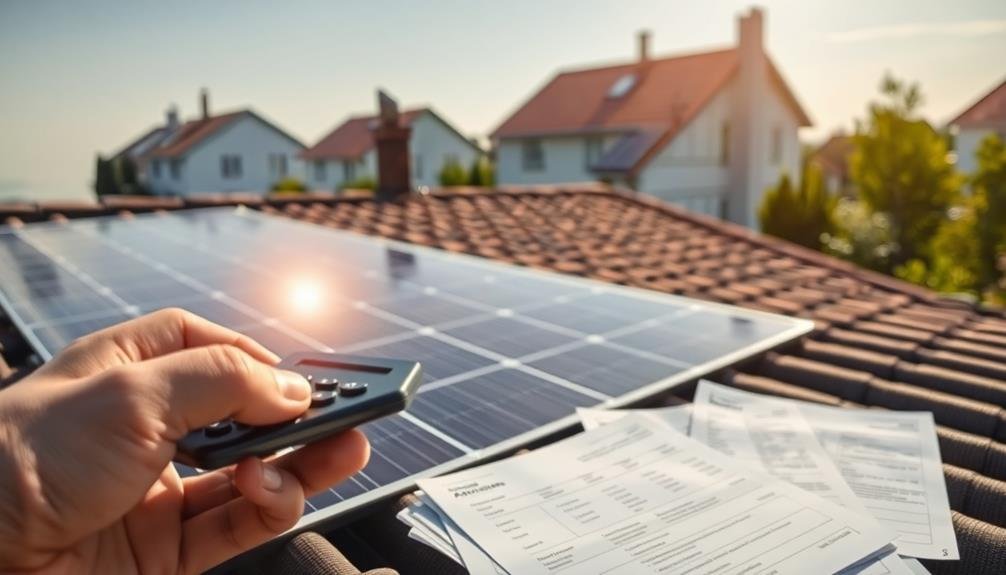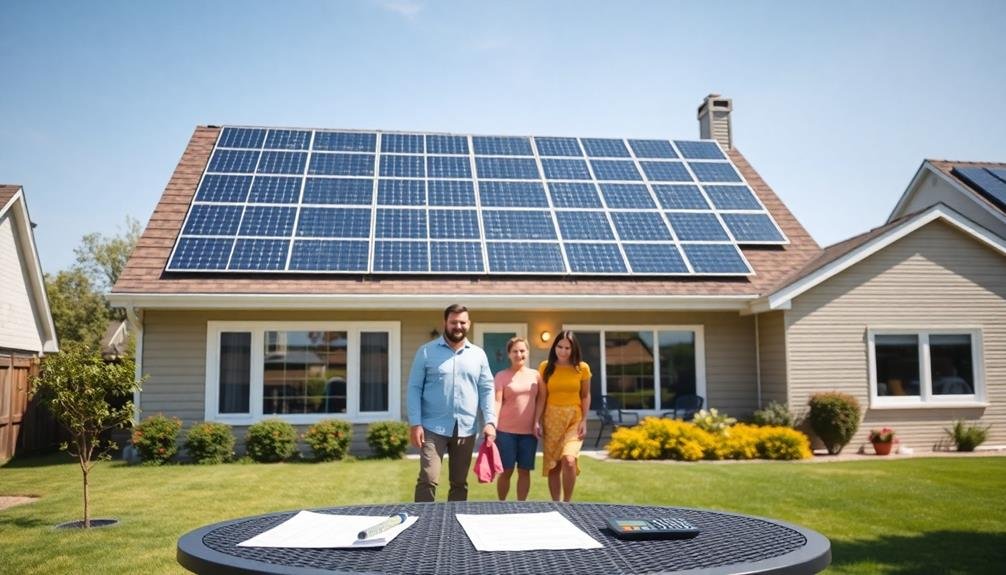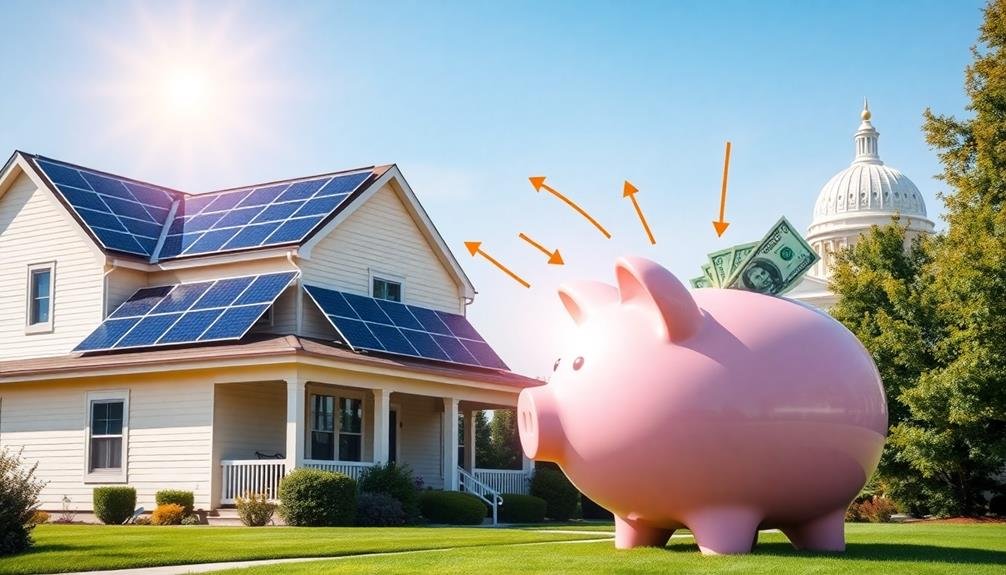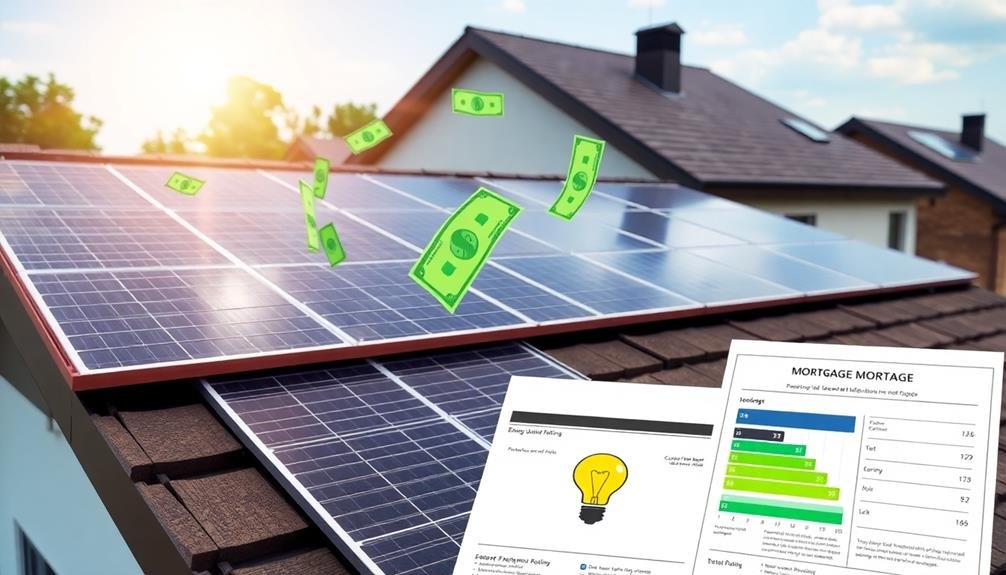When financing your photovoltaic roof, you've got several options to evaluate. A cash purchase offers the highest long-term savings, while home equity and solar-specific loans provide lower interest rates and longer repayment terms. Power Purchase Agreements and solar leases require no upfront costs but may limit your savings. Federal tax credits can greatly reduce your overall expenses, and innovative options like crowdfunding or manufacturer financing programs offer unique advantages. Energy-efficient mortgages allow you to finance both your home and solar installation together. Each option has its pros and cons, so it's essential to weigh them carefully. Exploring these choices in detail will help you make the best decision for your situation.
Cash Purchase Benefits

One of the most straightforward ways to finance your photovoltaic roof is through a cash purchase. By paying upfront, you'll avoid interest charges and loan fees, maximizing your long-term savings. You'll own the system outright, allowing you to take full advantage of available tax credits and incentives without sharing them with a third party.
Cash purchases typically result in the lowest overall cost of ownership. You'll see immediate returns on your investment through reduced electricity bills, and you won't have to worry about monthly loan payments. This option also provides the most flexibility, as you're not tied to any financing terms or agreements.
Additionally, a cash purchase can increase your home's value without adding to your debt load. You'll have complete control over the system and won't need to meet any credit requirements or go through approval processes.
If you're planning to stay in your home long-term, the cash purchase option offers the highest potential for long-term savings and return on investment. However, it's important to evaluate your available funds and other financial priorities before committing to this option.
Home Equity Loans
Homeowners with significant equity in their property can tap into this resource to finance their photovoltaic roof through a home equity loan. This option allows you to borrow against the value of your home, typically at a lower interest rate than personal loans or credit cards. You'll receive a lump sum upfront, which you can use to pay for your solar installation.
One advantage of home equity loans is their fixed interest rates, making your monthly payments predictable. They often have longer repayment terms, which can help keep your monthly payments manageable. Additionally, the interest on home equity loans used for home improvements may be tax-deductible, potentially reducing your overall costs.
However, there are risks to weigh. Your home serves as collateral, meaning you could lose it if you default on the loan. You'll also be increasing your overall debt, which could impact your credit score and financial flexibility.
Before choosing this option, carefully evaluate your ability to repay the loan and compare it with other financing methods. Remember that while a photovoltaic roof can save you money long-term, it's essential to confirm the financing doesn't strain your budget in the short term.
Solar-Specific Loans

As the solar industry has grown, many lenders have developed financing options tailored specifically for photovoltaic installations. These solar-specific loans offer unique advantages for homeowners looking to invest in a solar roof. Unlike traditional loans, they're designed with the particulars of solar projects in mind, often featuring longer terms and lower interest rates.
You'll find that solar-specific loans typically don't require home equity as collateral, making them accessible even if you've recently purchased your home. Many of these loans offer terms up to 20 years, aligning with the expected lifespan of your solar installation. This extended repayment period can result in lower monthly payments, potentially offset by your energy savings.
Some solar lenders provide performance guarantees, ensuring your system produces the promised amount of electricity. If it underperforms, they may cover the difference.
You'll also benefit from streamlined approval processes, as these lenders are familiar with solar projects and can quickly assess your application. However, be aware that interest rates may be slightly higher than home equity loans, so compare options carefully before deciding.
Power Purchase Agreements
Offering an alternative to traditional financing, Power Purchase Agreements (PPAs) allow you to benefit from solar energy without owning the system outright. With a PPA, a solar provider installs and maintains the photovoltaic system on your roof at no upfront cost. You'll then purchase the electricity generated by the system at a predetermined rate, typically lower than your current utility rates.
PPAs usually have terms of 15-25 years, during which you'll enjoy predictable electricity costs and potentially significant savings. At the end of the agreement, you may have options to extend the PPA, purchase the system, or have it removed.
Here's a comparison of key aspects between PPAs and traditional solar ownership:
| Aspect | PPA | Traditional Ownership |
|---|---|---|
| Upfront Costs | None | High |
| Maintenance | Provider's responsibility | Homeowner's responsibility |
| Electricity Rates | Fixed or escalating | N/A (offset by generation) |
| Tax Incentives | Claimed by provider | Claimed by homeowner |
While PPAs offer an easy entry into solar, they may not provide the same long-term savings as owning your system outright. Consider your financial goals and energy needs when deciding if a PPA is right for you.
Solar Leases

Another popular option for financing your photovoltaic roof is a solar lease. With this arrangement, you don't own the solar panel system outright. Instead, you're fundamentally renting the equipment from a solar company. You'll pay a fixed monthly fee to use the solar panels and benefit from the electricity they generate.
Solar leases typically last 20-25 years and often include maintenance and repairs as part of the agreement. This can be appealing if you're worried about potential repair costs or technological obsolescence. You'll start saving on your electricity bills immediately, as your lease payment is usually less than what you'd pay for traditional utility power.
However, there are some drawbacks to take into account. You won't be eligible for solar tax credits or rebates since you don't own the system.
Additionally, if you decide to sell your home, transferring the lease to a new owner can sometimes be complicated. It's also worth noting that your savings may be lower compared to owning the system outright, as the leasing company takes a portion of the financial benefits.
PACE Financing
PACE (Property Assessed Clean Energy) financing has emerged as an innovative way to fund your photovoltaic roof installation. This program allows you to finance your solar panels through property tax assessments, spreading the cost over an extended period. You'll repay the loan through an increase in your property taxes, often for up to 20 years.
One of PACE's main advantages is that it's not based on your credit score but on your property's equity. This makes it accessible to homeowners who might not qualify for traditional loans. Additionally, PACE financing is transferable if you sell your home, as the assessment stays with the property.
Here's a breakdown of PACE financing characteristics:
| Feature | Description |
|---|---|
| Eligibility | Based on property equity |
| Repayment | Through property tax assessments |
| Term | Up to 20 years |
| Interest Rates | Typically fixed |
| Transferability | Yes, stays with property |
While PACE can be an attractive option, it's important to evaluate potential drawbacks. Some mortgage lenders may be hesitant to approve loans for properties with PACE assessments, and the interest rates can be higher than traditional loans. Be sure to compare PACE with other financing options before making your decision.
FHA PowerSaver Loans

The Federal Housing Administration (FHA) extends a helping hand to homeowners looking to finance their solar panel installations through PowerSaver Loans. These loans are designed to make energy-efficient home improvements more accessible and affordable for homeowners across the United States.
With FHA PowerSaver Loans, you can borrow up to $25,000 for a term of up to 20 years. The interest rates are typically lower than traditional home improvement loans, making it an attractive option for those looking to invest in solar energy.
You'll need to meet certain credit requirements and have sufficient equity in your home to qualify.
Here are some key features of FHA PowerSaver Loans:
- Low down payment requirements
- Fixed interest rates
- No prepayment penalties
- Can be combined with other financing options
To apply for an FHA PowerSaver Loan, you'll need to work with an approved lender. They'll guide you through the application process and help you determine if this financing option is right for your photovoltaic roof project.
Green Mortgages
Green mortgages, also known as energy-efficient home loans, offer you an attractive financing option for your photovoltaic roof.
You'll benefit from lower interest rates compared to traditional mortgages, making your solar investment more affordable.
These loans also increase your borrowing capacity, allowing you to finance both your home purchase and energy-efficient upgrades in one package.
Energy-Efficient Home Loans
Energy-efficient home loans, also known as green mortgages, offer a unique financing option for homeowners looking to install photovoltaic roofs. These loans provide additional funds on top of your primary mortgage to cover the costs of energy-efficient upgrades.
They're designed to recognize the long-term savings and increased home value that come with eco-friendly improvements.
When you're considering a green mortgage for your solar roof project, keep these key points in mind:
- You'll typically need to have an energy audit performed on your home
- The loan amount is based on the projected energy savings
- Interest rates may be lower than traditional mortgages
- You can often roll the costs into your existing mortgage
Green mortgages are available through various lenders, including government-backed programs like FHA and VA loans. They can be used for both new home purchases and refinancing existing properties.
By choosing this financing option, you're not only investing in your home's energy efficiency but also potentially increasing its resale value.
Remember to compare offers from multiple lenders and consider the long-term benefits of reduced energy costs when weighing your decision.
Lower Interest Rates
Offering a compelling incentive for eco-conscious homeowners, green mortgages often come with lower interest rates compared to traditional home loans. These reduced rates can translate into significant savings over the life of your mortgage, making the installation of a photovoltaic roof more financially attractive.
When you opt for a green mortgage to finance your solar panel installation, you're likely to secure an interest rate that's 0.25% to 0.5% lower than standard mortgage rates. This reduction may seem small, but it can add up to thousands of dollars in savings over time.
For example, on a $300,000 loan with a 30-year term, a 0.5% lower interest rate could save you over $30,000 in interest payments.
To qualify for these lower rates, you'll need to meet specific energy efficiency criteria set by the lender. This typically involves having your home's energy performance assessed and reaching a certain efficiency threshold.
By investing in a photovoltaic roof, you're not only reducing your carbon footprint but also positioning yourself to benefit from these favorable loan terms.
Remember to shop around and compare offers from different lenders to guarantee you're getting the best possible rate for your green mortgage.
Increased Borrowing Capacity
When you're eyeing a photovoltaic roof, you'll be pleased to know that green mortgages often come with increased borrowing capacity.
These specialized loans recognize the long-term value and energy savings of eco-friendly home improvements. Lenders may allow you to borrow more than you'd with a traditional mortgage, factoring in the projected energy savings from your solar roof.
This increased borrowing capacity can be a game-changer, enabling you to invest in a higher-quality photovoltaic system or cover additional costs associated with the installation.
It's not uncommon for lenders to increase your loan amount by 10-15% when you're financing a green home improvement like a solar roof.
Here's what you need to know about increased borrowing capacity with green mortgages:
- Lenders may add projected energy savings to your income when calculating your debt-to-income ratio
- You might qualify for a larger loan amount without a significant increase in monthly payments
- The extra borrowing capacity is often capped at a percentage of the home's value
- Some lenders require an energy audit to verify potential savings and determine the increased loan amount
State and Local Incentives

Exploring state and local incentives can greatly reduce the cost of your photovoltaic roof installation. Many states offer tax credits, rebates, or grants to homeowners who invest in solar energy systems. These incentives can markedly lower your upfront costs and improve your return on investment.
Check your state's energy office or public utilities commission website for available programs. Some states provide performance-based incentives, paying you for the electricity your system generates over time. Others offer property tax exemptions, ensuring your home's increased value from solar panels doesn't result in higher property taxes.
Local governments and utilities may also offer their own incentives. These can include rebates, low-interest loans, or expedited permitting processes for solar installations. Some utilities provide net metering programs, allowing you to sell excess electricity back to the grid.
To maximize your savings, combine state and local incentives with federal tax credits. Research all available options and consult with a solar installer or financial advisor to determine which incentives you qualify for.
Federal Tax Credits
Federal tax credits provide a significant boost to homeowners considering a photovoltaic roof installation. The Investment Tax Credit (ITC) allows you to deduct 30% of the cost of your solar system from your federal taxes. This credit applies to both residential and commercial installations, making it a powerful incentive for going solar.
To claim the ITC, you'll need to file IRS Form 5695 with your tax return. It's crucial to recognize that the credit is non-refundable, meaning you can't get more back than you owe in taxes. However, you can carry forward any unused portion of the credit to future tax years.
The federal tax credit offers several advantages:
- Significant cost reduction for your photovoltaic roof
- No upper limit on the credit amount
- Applies to both equipment and installation costs
- Can be combined with state and local incentives
Remember that the 30% credit is set to step down in the coming years, so it's wise to act sooner rather than later.
Consult with a tax professional to ascertain you're maximizing your benefits and complying with all IRS requirements when claiming the credit.
Crowdfunding for Solar Projects

Leveraging the power of community support, crowdfunding has emerged as an innovative financing option for solar projects. This method allows you to raise funds for your photovoltaic roof by soliciting small contributions from a large number of people, typically through online platforms.
To start a crowdfunding campaign for your solar project, you'll need to choose a suitable platform like Kickstarter, Indiegogo, or specialized green energy platforms. Craft a compelling story about your project, explaining its environmental impact and potential benefits to the community. Set a realistic funding goal and offer attractive rewards to incentivize backers.
You'll need to promote your campaign actively through social media, local networks, and environmental groups. Be transparent about how you'll use the funds and provide regular updates to maintain backers' trust.
Remember that crowdfunding isn't guaranteed success – it requires significant effort and marketing skills.
While crowdfunding can be an excellent way to finance your solar project, it's important to weigh potential drawbacks. These include platform fees, the possibility of not reaching your funding goal, and the time and effort required to run a successful campaign.
Manufacturer Financing Programs
Many solar panel manufacturers offer their own financing programs to make purchasing a photovoltaic roof more accessible. These programs often come with competitive interest rates and flexible terms tailored to solar installations. You'll find that manufacturer financing can simplify the process, as you're dealing directly with the company providing your panels.
When considering manufacturer financing, it's important to compare offers from multiple providers. Look for programs that offer:
- Low or zero down payment options
- Fixed interest rates for the life of the loan
- No prepayment penalties
- Extended warranty coverage included in the financing package
Remember that while manufacturer financing can be convenient, it may not always offer the best rates. You'll want to compare these programs with other financing options, such as home equity loans or specialized solar loans from banks.
Be sure to read the fine print and understand all terms and conditions before committing to a manufacturer's financing program. Some companies may require you to use their installation services or specific equipment, which could limit your choices.
Always calculate the total cost of the loan, including interest, to guarantee you're getting the best deal for your photovoltaic roof investment.
Energy-Efficient Mortgage Options

Energy-efficient mortgages (EEMs) offer a unique way to finance your photovoltaic roof as part of your home purchase or refinance. These specialized mortgages allow you to borrow extra money to cover the cost of energy-efficient improvements, including solar panel installations. EEMs are available through various lenders and are backed by federal agencies like FHA, VA, and Fannie Mae.
When you apply for an EEM, you'll need to have a home energy assessment conducted to determine the potential savings from your solar roof. The lender will then factor these savings into your debt-to-income ratio, potentially qualifying you for a larger loan amount. This means you can finance your photovoltaic system without greatly increasing your monthly mortgage payments.
EEMs come with several benefits. You'll enjoy lower energy bills from day one, potentially offsetting the additional loan amount. The increased home value from your solar installation may also provide a cushion against market fluctuations.
However, be aware that EEMs may have slightly higher interest rates than traditional mortgages. It's important to compare offers from multiple lenders and consider the long-term savings versus the initial costs before deciding if an EEM is right for you.
Frequently Asked Questions
How Long Does It Take to Recoup the Investment in a Photovoltaic Roof?
You'll typically recoup your investment in a photovoltaic roof within 7-20 years, depending on factors like sunlight exposure, energy costs, and system efficiency. It's a long-term investment that'll eventually pay off through reduced electricity bills.
Can I Install Solar Panels on a Roof That Needs Replacing Soon?
It's not advisable to install solar panels on a roof that needs replacing soon. You'll want to replace your roof first, then add the panels. This guarantees a stable foundation and avoids costly panel removal and reinstallation later.
What Happens to My Solar Financing if I Sell My House?
If you sell your house, you'll typically have options for your solar financing. You can transfer the loan to the new owner, pay it off with the sale proceeds, or potentially move the panels to your new home.
Are There Insurance Considerations for Installing a Photovoltaic Roof System?
Yes, there are insurance considerations. You'll need to update your homeowner's policy to cover your new solar system. It may increase your premium, but it'll protect your investment against damage or theft. Don't forget to inform your insurer.
How Do Extreme Weather Conditions Affect the Efficiency of Solar Panels?
Extreme weather can impact your solar panels' efficiency. You'll see reduced output during heavy cloud cover or snowfall. High temperatures can slightly decrease performance. Strong winds and hail may cause physical damage, affecting long-term efficiency.
In Summary
You've got plenty of options to finance your photovoltaic roof. Whether you choose cash, loans, leases, or innovative solutions like crowdfunding, there's a path that'll work for you. Don't forget to take advantage of federal tax credits and explore energy-efficient mortgage options. By carefully weighing the pros and cons of each method, you'll find the perfect financing solution to power your home with solar energy and save money in the long run.





Leave a Reply